Wire cross section for home wiring: how to correctly calculate
The installation of the household electrical network must be carried out so that users can easily turn on several powerful electrical appliances at the same time. Therefore, it is necessary to select the wire cross section for home wiring based on a competent calculation of the parameters of the apartment and house electrical network.
There are several calculation methods. We offer to get acquainted with different approaches and choose the best option. In addition to the technology for calculating the cross-section of the wire, the article describes the main parameters for choosing the wiring and indicates the regulatory restrictions on the maximum power of electrical appliances.
The content of the article:
Why know the parameters of the wire
Standard power sockets are designed for a continuous current of 16 A, which corresponds to a maximum power of the included device of 3.52 kW. Usually a copper cable with a cross section of 2.5 mm is connected to them2, which can be misleading when choosing the type of wire for the rest of the electrical wiring.
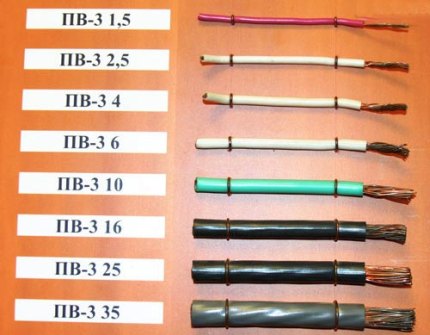
When electrons move through a metal, part of the energy is dissipated in the form of heat. With a large current and a small cable section, the thermal component can lead to overheating of the metal and the melting of its shell.
In domestic conditions, this can initiate both an internal wall short circuit and a fire in open wires, especially in places of excesses.
As a result, the following situations may arise:
- Large-scale fireif there is flammable material near the cable.
- Current leak with incomplete fusion of the core sheath. This leads to a meaningless consumption of electricity and the likelihood of electric shock to residents.
- Imperceptible wire break in the wall. As a result, part of the apartment or the entire room is de-energized. After this, the search for the gap and the subsequent replacement of the wiring with local wall repair is required.
The choice of a thick electric wire for an apartment, with a margin, also has one minus - an overrun of financial resources, which does not make sense. Therefore, the choice of wiring cross-section is best done using calculation methods to avoid all of the above problems.
Cross-sectional selection factors
Not only the power of the device determines the nature of the necessary electrical wiring. There are other factors, the influence of which must be taken into account when calculating the required cable section. They can affect the heat generation in the conductor, its fire hazard and performance.
To such wire selection factors include:
- Core material: copper, aluminum.
- Type of insulation: PTFE, PVC, PE and other plastics.
- The length of the wire from the current source to the device.
- Wiring Method: open installationhidden in the wall or using cable channels.
- The temperature regime in the room.
- Number of phases and mains voltage.
- Wiring diagram.
Copper has a lower resistance than aluminum, therefore, calculations for these materials are performed separately. The cross section of a copper core can be approximately 1.5 times smaller than that of aluminum.
Insulation material also affects the choice of electrical wire. There are special sheaths that withstand high temperatures without melting and resistance changes, so these cables can be subjected to increased loads and used at elevated temperatures.
The degree of voltage drop depends on the length of the wire and its cross section; therefore, for the operation of sensitive electronics, these parameters must also be taken into account.
Closed in ducts or plastered in the wall electric wires to a lesser extent lose heat during prolonged loads, therefore they overheat faster and require a larger design cross-section.
The wiring going from the meter to the junction boxes can generally be subjected to simultaneous load from several devices included in various sockets. Therefore, the calculation of the cross section of these cable sections must be done separately.
Also, the load on the electric cable depends on the voltage and the number of phases supplied. But since a single-phase wiring with a voltage of 220 V is mainly used in everyday life, the influence of this factor will not be considered.
The technique for determining the cross section of home wiring
When calculating the cross section of the core of the electric cable at installation of home wiring many factors are taken into account. There are special computer programs that allow you to take into account all the features of the house and the needs of its residents. But you can determine the section necessary for wiring and independently, using the described methodology.
It is important to understand that the diameter of the wires in the apartment may vary from room to room. At the entrance to the electric meter, it is one, at the junction box the wire cross-section may already be smaller, at sockets and lamps - even less.
At each section of the wiring, it is desirable to determine the parameters necessary for it, so as not to overpay for excessively thick wires.
If you do not want to calculate the cross-section of the wiring being laid, you can use the recommendations of experienced electricians who state:
Calculation of the power of devices
The simplest method for determining the required wire cross-section is its calculation, taking into account the power of the operated electrical appliances and correction factors. This technique involves several stages.
Stage number 1. Summing the power of electrical appliances. Ideally, you need to know the nominal energy consumption of each device, which is indicated on its label. If the living space is still unfurnished, then you can calculate the estimated demand for electricity using the following table No. 1.
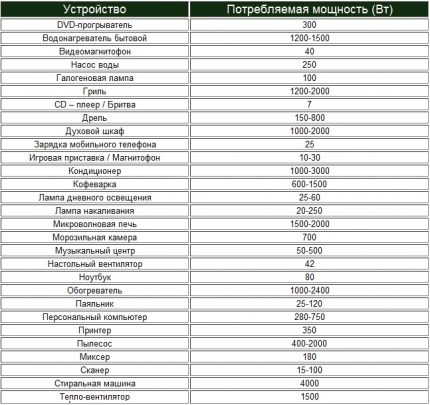
When calculating, you can also use the parameters of devices that are located in similar apartments of relatives or friends. There is another option - to go to a household appliance store, see its characteristics, and at the same time look after a suitable model of equipment for the home.
Stage number 2. Determination of simultaneity coefficient. It can be expressed as a percentage or in a numerical value from 0 to 1. The coefficient shows the ratio of electricity consumption by devices simultaneously connected to the network to the total power of all home devices, calculated in the first stage.
Typically, the coefficient is 0.8, but you can calculate it yourself, based on the habits of home residents.
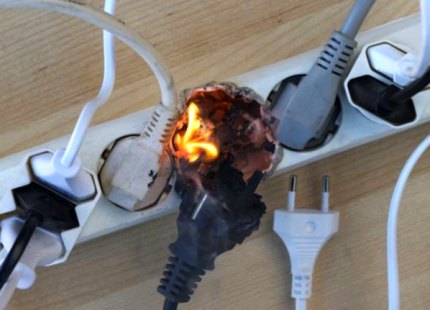
Stage number 3. Determination of safety factor. This indicator takes into account the possible increase in electricity consumption in a few years. Usually it is taken equal to 1.5-2, but if the house already has a complete set of electrical appliances, then the coefficient value can be taken 1.2-1.3.The main thing is not to regret the small cross-section of wires in the future.
Stage number 4. Maximum Load Calculation.
It is produced by the formula:
P = (P (1) + P (2) + .. P (N)) * J * K,
Where:
- P - maximum permissible load in W;
- P (1) + P (2) + .. P (N) - the sum of the rated capacities of all electrical appliances;
- K - simultaneity coefficient;
- J - safety factor.
For example, if the total power of the devices is 7500 W, the simultaneity coefficient is 0.8, and the safety factor is 1.5, then the maximum allowable load will be:
P = 7500 * 0.8 * 1.5 = 9000 watts.
This indicator will be used in subsequent calculations.
Stage number 5. Determination of the maximum allowable current.
The indicator is determined by a simple formula:
I = P / U,
Where:
- I - permissible current strength;
- P - maximum permissible load in W;
- U - the voltage in the network is 220 V.
Using the data of the fourth stage, you can determine the maximum allowable current:
I = 9000W / 220V41A.
The method for calculating the cable cross-section by power and current is described in detail in this article.
Stage number 6. Calculation of cable cross-section according to the table. Since the optimal choice of wire for home wiring is influenced not only by the parameters of the devices, but also by external factors (core material, its sheath, wiring diagram, etc.), for each case there are tables of their own, which are discussed below.
The definition of the cross section of the cable according to the tables
To determine the optimal wire cross section for home wiring, there are special tables. All of them are focused on the value of the permissible current strength, which is calculated separately according to the above methodology. Next, table options will be considered. determine the cross-section of the wiring.
The calculation of the cross section of ordinary household wires is presented in the tables:
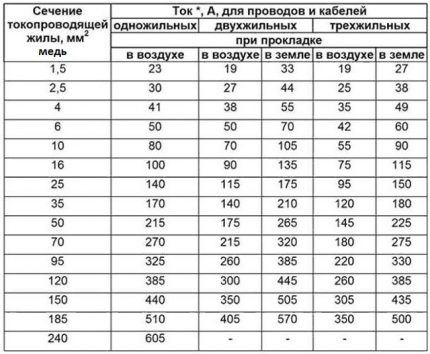
Below is a calculation of the cross-section of wires for transfers and extension cords.
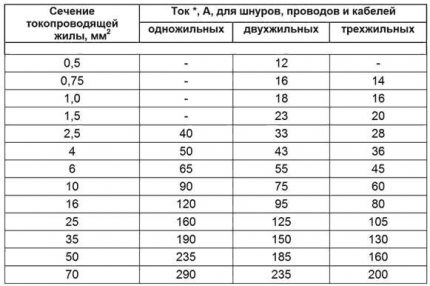
The current load on the power cable with open and closed laying is different. But they are considered the same if the wire is laid in the ground in a wide tray. This allows the cable to give off heat to the surrounding air and heat up less.
The calculation of the cross section for copper and aluminum conductors, depending on the method of laying the cable, is given in the table.
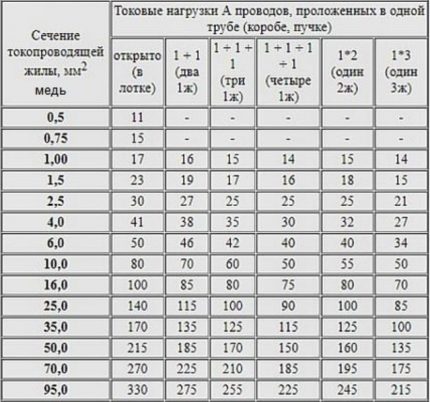
Similar tables are used in the calculation of wiring and in industry. Household cables are usually arranged much simpler, therefore, the number of calculation materials for them is quite limited. The parameters indicated in the tables are not invented, but are indicated in industry standards, for example, in GOST 31996-2012.
Voltage drop calculation
Not only the degree of heating of the core, but also the voltage at the far end of the wire depends on the cross section of the electric cable. Household appliances are designed for certain parameters of the power supply network, and their constant inconsistency can lead to a decrease in the life of the equipment.
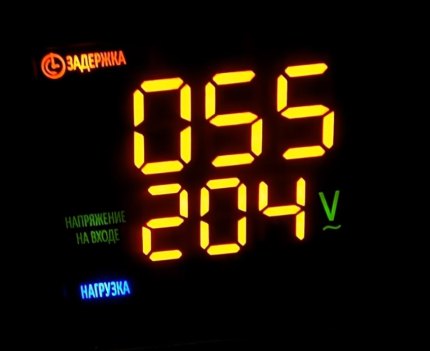
When the cable is extended, a voltage drop occurs. This effect can be reduced by increasing the cross-section of the wiring. A decrease in voltage at the end of the wire by 5% is considered critical, compared with its value at the current source.
This indicator can be calculated using the well-known formula:
Uad = I * 2 * (ρ * L) / S,
Where:
- ρ - metal resistivity, Ohm * mm2 / m;
- L - cable length, m;
- S - conductor cross section in mm2;
- Upfall - voltage drop, volt;
- I - current flowing through the conductor.
If the calculated voltage drop is more than 5% of the nominal, then you need to use a cable with a large cross-section. This will ensure stable operation of the equipment.
Heating boilers, washing machines and other devices with many relays and sensors are particularly sensitive to voltage. This feature must be taken into account when using transfers.
Regulatory restrictions
Utilities providing the population with electricity are entitled to impose restrictions on the maximum total power of appliances in the apartment. This can be achieved by installing electricity meters with a certain bandwidth.
The device is equipped with automatic disposable or reusable fuses, which are triggered when the threshold value of the current is exceeded.
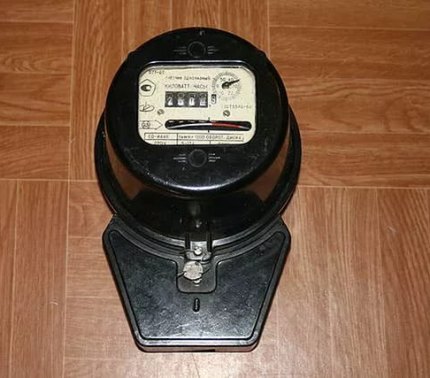
If you remove the plugs from the meter and connect it directly to the apartment wiring, then it is guaranteed to burn out after a prolonged violation of the operating mode. Most Soviet meters installed in apartments withstand a peak load of 25 A for up to 1 minute.
After that, they burn out, which is fraught with payment for installing a new device and a fine for violating operating rules.
Wiring in the entrance is also capable of not withstanding high loads, the burnout of which can disconnect several apartments at once. Therefore, when connecting an apartment to an internal house network with a 2.5 mm cable, you should not expect that a thicker internal apartment wire will be able to withstand high loads.
It is especially important to consider the factor of regulatory restrictions at the stage of planning the installation of electric heating, underfloor heating, infrared saunas and other energy-intensive equipment.
Previously, you need to consult about the possibilities of electrical equipment installed in front of the apartment in the relevant utilities.
If you decide to calculate the wiring parameters yourself, then it will be useful for you to understand such concepts as: current strength, power and voltage. More details in the article - How to calculate power, current and voltage: principles and examples of calculation for domestic conditions
Conclusions and useful video on the topic
The videos contain practical tips for electricians on choosing and buying home wiring. They will help to purchase equipment suitable for the cable, which will accurately protect the housing from possible problems with network congestion.
Choosing a cable section in a store
Correspondence of the cable section and the parameters of the circuit breaker
The choice of cable and machine section:
Errors when choosing an electrical cable:
The main factors when choosing a cable for home wiring are the power of household appliances and the limitations of the electrical networks that provide electrical energy to the apartment.
Having correctly selected the cross-section of the wire, you can include in the network all the necessary electrical appliances. This eliminates the inconvenience of operating the equipment and allows you to prevent fire of the wiring.
Have something to supplement, or have questions about calculating the wiring cross-section? Please leave comments on the publication, participate in discussions of the material. The contact form is located in the lower block.

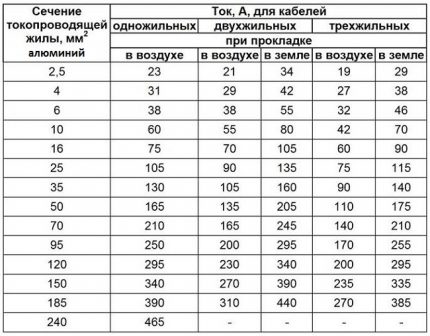
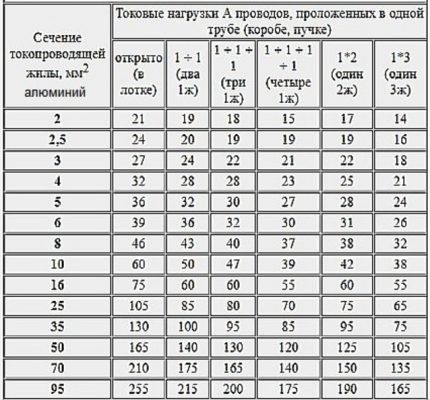
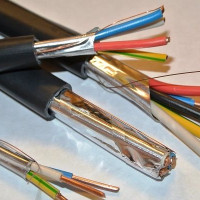 Calculation of cable cross-section by power and current: how to calculate wiring correctly
Calculation of cable cross-section by power and current: how to calculate wiring correctly 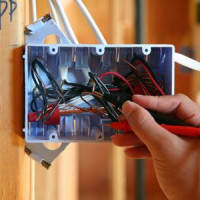 Which wire to use for wiring in the house: recommendations for selection
Which wire to use for wiring in the house: recommendations for selection 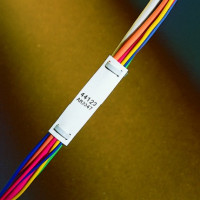 What cable to use for wiring in the apartment: a review of the wires and choosing the best option
What cable to use for wiring in the apartment: a review of the wires and choosing the best option 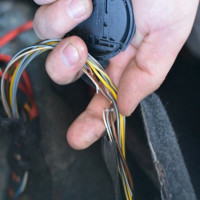 How to find a wire break in a wall: an overview of ways to detect and repair a break
How to find a wire break in a wall: an overview of ways to detect and repair a break  Cable for the Internet: varieties, device + what to look for when buying wire for the Internet
Cable for the Internet: varieties, device + what to look for when buying wire for the Internet 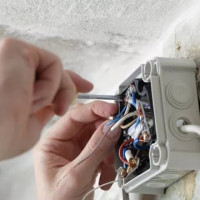 Junction box for indoor and outdoor wiring: types, classification + installation instructions
Junction box for indoor and outdoor wiring: types, classification + installation instructions  How much does it cost to connect gas to a private house: the price of organizing gas supply
How much does it cost to connect gas to a private house: the price of organizing gas supply  The best washing machines with dryer: model rating and customer tips
The best washing machines with dryer: model rating and customer tips  What is the color temperature of light and the nuances of choosing the temperature of the lamps to suit your needs
What is the color temperature of light and the nuances of choosing the temperature of the lamps to suit your needs  Replacement of a geyser in an apartment: replacement paperwork + basic norms and requirements
Replacement of a geyser in an apartment: replacement paperwork + basic norms and requirements
Choosing the right cable for home wiring and correctly calculating the required cross-section is a very responsible matter on which the security of your apartment and its residents will depend. Do not save on this. Give up aluminum in favor of copper stranded cable with reliable insulation. It is also important to install circuit breakers that will not allow long-term operation of electrical wiring at currents close to maximum.
Good afternoon, Ivan Sergeevich.
Please note that the article gives an example of calculating the cross section of a wire. The author emphasizes that, having received the calculated value, it is necessary to choose a larger standard value of the section according to the PUE. That is, the mathematical formula, the selection algorithm do not provide for the opportunity to "save."
Regarding automatic machines - they allow networks to carry the load, determined by the cross-section of wires, cables that can be overloaded - machines are designed with this factor in mind. In other words, they do not turn off at certain values and time intervals of overcurrents. Some cables allow 30% overload (Screenshot with examples from PTE EP attached).